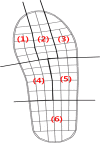The Effect of Different Foot Orthosis Inverted Angles on Plantar Pressure in Children with Flexible Flatfeet
- PMID: 27458719
- PMCID: PMC4961415
- DOI: 10.1371/journal.pone.0159831
The Effect of Different Foot Orthosis Inverted Angles on Plantar Pressure in Children with Flexible Flatfeet
Abstract
Although orthotic modification using the inverted technique is available for the treatment of flatfoot, empirical evidence for the biomechanical effects of inverted-angle foot orthoses (FOs) is lacking. The aim of this study was to evaluate the effects of different FO inversion angles on plantar pressure during gait in children with flatfoot. Twenty-one children with flexible flatfeet (mean age 9.9 years) were enrolled in this study. The plantar pressures were measured for the rearfoot; medial and lateral midfoot; and medial, central, and lateral forefoot as participants walked on a treadmill while wearing shoes only and shoes with the following 3 orthotic conditions: (i) orthosis with no inverted angle, (ii) orthosis with a 15° inverted angle, and (iii) orthosis with a 30° inverted angle. A one-way repeated measures analysis of variance (ANOVA) with the Bonferroni-adjusted post-hoc test was used to compare the mean values of each orthotic condition. Compared with the shoe only condition, the peak pressure decreased significantly under the medial forefoot and rearfoot with all FOs (p <0.05). However, no significant differences in the peak pressure under the medial forefoot and rearfoot were observed between the FOs. The peak pressure under the medial midfoot increased significantly with all FOs, and a maximal increase in the peak pressure was obtained with a 30° inverted angle orthosis. Furthermore, the contact area under the medial midfoot and rearfoot increased significantly with all FOs, compared with the shoe only condition (p <0.05). Again, no significant differences were observed between the FOs. For plantar pressure redistribution, a FO with a low inverted angle could be effective, accommodative, and convenient for children with flatfoot.
Conflict of interest statement
Figures
References
-
- Bordelon RL. Hypermobile flatfoot in children. Comprehension, evaluation, and treatment. Clin Orthop Relat Res. 1983;181:7–14. - PubMed
-
- Kuhn DR, Shibley NJ, Austin WM, Yochum TR. Radiographic evaluation of weight-bearing orthotics and their effect on flexible pes planus. J Manipulative Physiol Ther. 1999;22:221–6. - PubMed
-
- Lee CR, Kim MK, Cho MS. The relationship between balance and foot pressure in fatigue of the plantar intrinsic foot muscles of adults with flexible flatfoot. Journal of Physical Therapy Science. 2012;24:699–701.
-
- Franco AH. Pes cavus and pes planus: analyses and treatment. Phys Ther.1987;67:688–94. - PubMed
-
- Ledoux WR, Hillstrom HJ. The distributed plantar vertical force of neutrally aligned and pes planus feet. Gait Posture. 2002;15:1–9. - PubMed
Publication types
MeSH terms
LinkOut - more resources
Full Text Sources
Other Literature Sources
Medical



